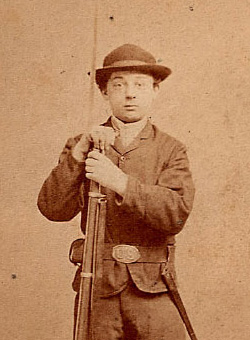
Please send all Checks and Money orders to :
Dave Taylor P.O. Box 87 Sylvania, OH 43560
419-842-1863
Click Here to E-mail Us!
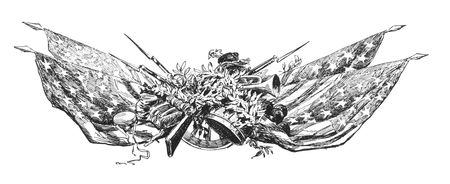

17-04-01

17-03-52… EXTREMELY HISTORICAL 12th CORPS OFFICER’S SABER — KILLED IN ACTION AT PEACHTREE CREEK, GEORGIAN WHILE ON GEARY’S STAFF! …… After Atlanta General Geary wrote…. “My loss in valuable officers was particularly severe. Capt. Thomas H. Elliott, assistant adjutant-general on my staff, was killed instantly in the thickest of the battle. His death was a severe loss to me personally, as well as to my division. He had served with me as assistant-adjutant general for nearly three years and was distinguished for his ability and gallantry.” This ia a very cool Horstmann cavalry officer’s saber carried by an officer on Geary’s staff who was mentioned several times in the Official Records, and who is shown with Geary and other officers, holding this very sword in a photograph in the National Archives. Not only that, the scabbard shows an old break, likely resulting from his fall when struck at the Battle of Peachtree Creek. Perfectly appropriate for a mounted staff officer, this one of Horstmann’s “field use” or “campaign grade” cavalry officer’s sabers with a very plain hilt showing some floral decoration around the edge of the pommel cap but no decoration on the quillon, branches or counterguard. The grip is leather wrapped with a standard twisted brass wire binding. The blade is the correct flat back pattern used by Horstmann on these and shows the Horstmann/ & Sons stamp on one side of the ricasso and the Weyersberg king’s head over “Philadelphia” on the other. The blade is plain and the scabbard is simple, with just the drag showing some extra work to mark it as an officer’s example. There is an old break in the scabbard, not quite but almost all the way through, just above the lower band. A small dab of solder was added in modern times to keep it from breaking all the way through. My own feeling is that the break probably resulted when Elliott fell. As a staff officer, he was likely mounted when he was struck and killed in the fighting. Had it happened earlier, Elliott would have changed scabbards, and it had to have happened when the scabbard was empty and the sword drawn. In any case, the blade is clean and a smooth dull silver-gray in color with a good edge and point. The grip leather and wire are in place and good. The brass has a mellow patina. The right side of the quillon has a small notch or shallow crack that I can only think was done, like the damage to the scabbard, when Elliott fell. Engraved on the knuckle guard in dead-real period script is “Capt. T.H. Elliott / A.A.G.” Thomas Hollingsworth Elliott was a 24-year-old resident of Philadelphia when he enlisted in the 28th Pennsylvania Infantry under Colonel John White Geary, a prominent politician who had served in the Mexican War, being wounded several times, later governed the Kansas Territory and after the war served as governor of Pennsylvania. Elliott was commissioned a 1st Lieutenant in Co. H on 7/11/61. Geary must have been impressed with Elliott, for after Geary was commissioned Brigadier General in April, 1862, he brought Elliott onto his staff as Assistant Adjutant General in July. Elliott was discharged from the 28th PA on 7/29/62 for promotion and commissioned the same day as Captain and Assistant Adjutant General in the US Volunteers. Geary was assigned to Pope’s Army of Virginia, and was wounded at Cedar Mountain, returning in October to command a division in the 12th Corps, Army of the Potomac. After Elliott’s death, Geary remarked that he had served with him for almost three years, indicating his presence with Geary throughout. The division was heavily engaged at Chancellorsville in May, 1863, and Geary mentioned Elliott and thanked him for his services in his Official Records report. At Gettysburg the division was engaged on July 2 on Culps Hill and in the Fall went west with the rest of the 12th Corps. Geary performed well in the Chattanooga Campaign, particularly at Wauhatchie and Lookout Mountain, and mentions Elliott in his official reports. Elliott’s luck ran out in the Atlanta Campaign. Hood took over from Johnston and tried to make up lost ground by attacking Sherman at Peachtree Creek. Geary wrote, “I have never seen more heroic fighting. For three hours the fury of battle along our entire line could not be surpassed,” and reported his men were attacked from three sides. He recorded Elliott’s death in his official report and later referred to him as the “lamented Elliott.” Elliott’s body was returned to Pennsylvania and interred in Philadelphia. This is accompanied by a huge binder filled with research by a previous owner that must be three inches thick, you won’t have to spend much time searching for research material it is all included. This is a significant field-used sword belonging to an heroic officer killed in one of the big battles of the war. I note that a common dog tag of a KIA soldier from Norm Flayderman’s collection brought over four thousand dollars at auction this year. Good heavens… here is a battle carried KIA sword for less. $3,950.00sold
Call us @ 419-842-1863
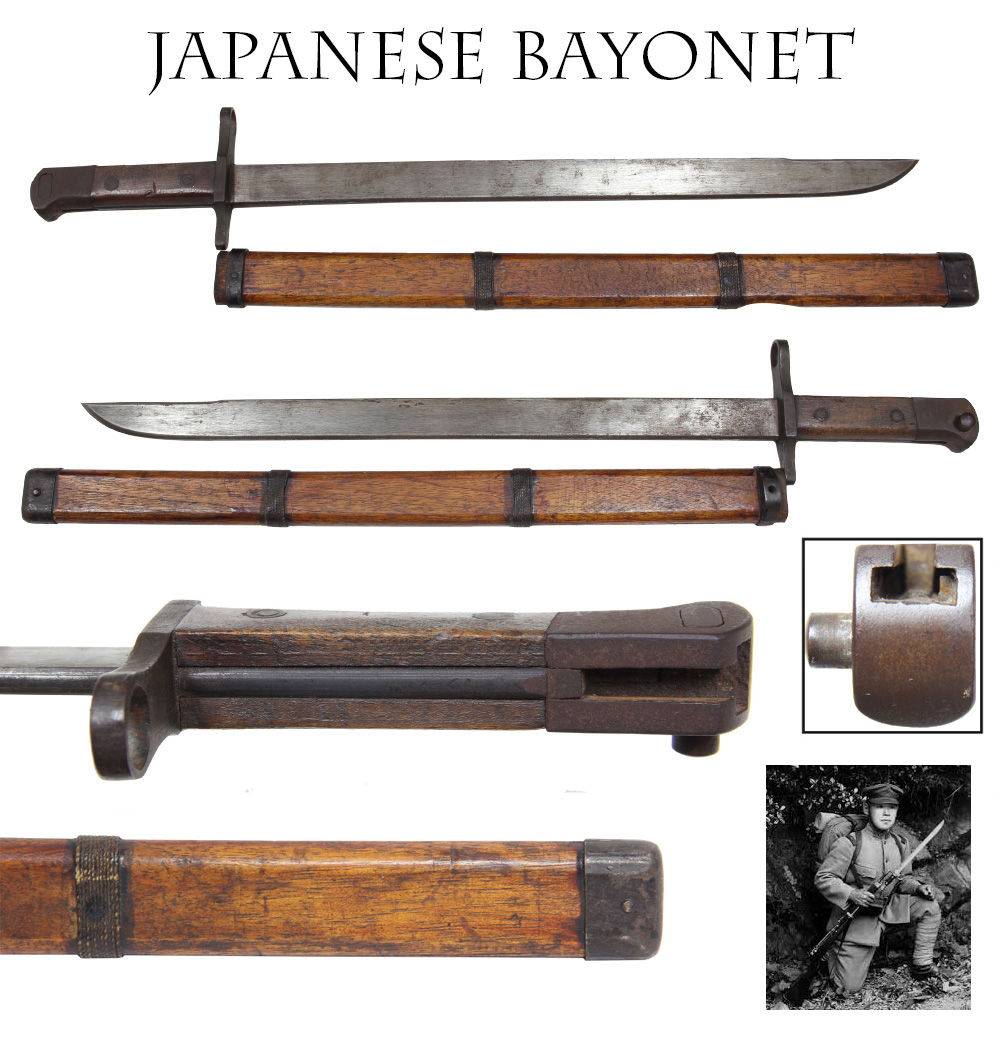
17-03-29…LATE WAR NEAR MINT JAP BAYONET: Classic WW-2 Jap bayonet in wooden scabbard. Near perfect condition and classic late war “last ditch” crude construction.
$145.00 … Sold
Call us @ 419-842-1863
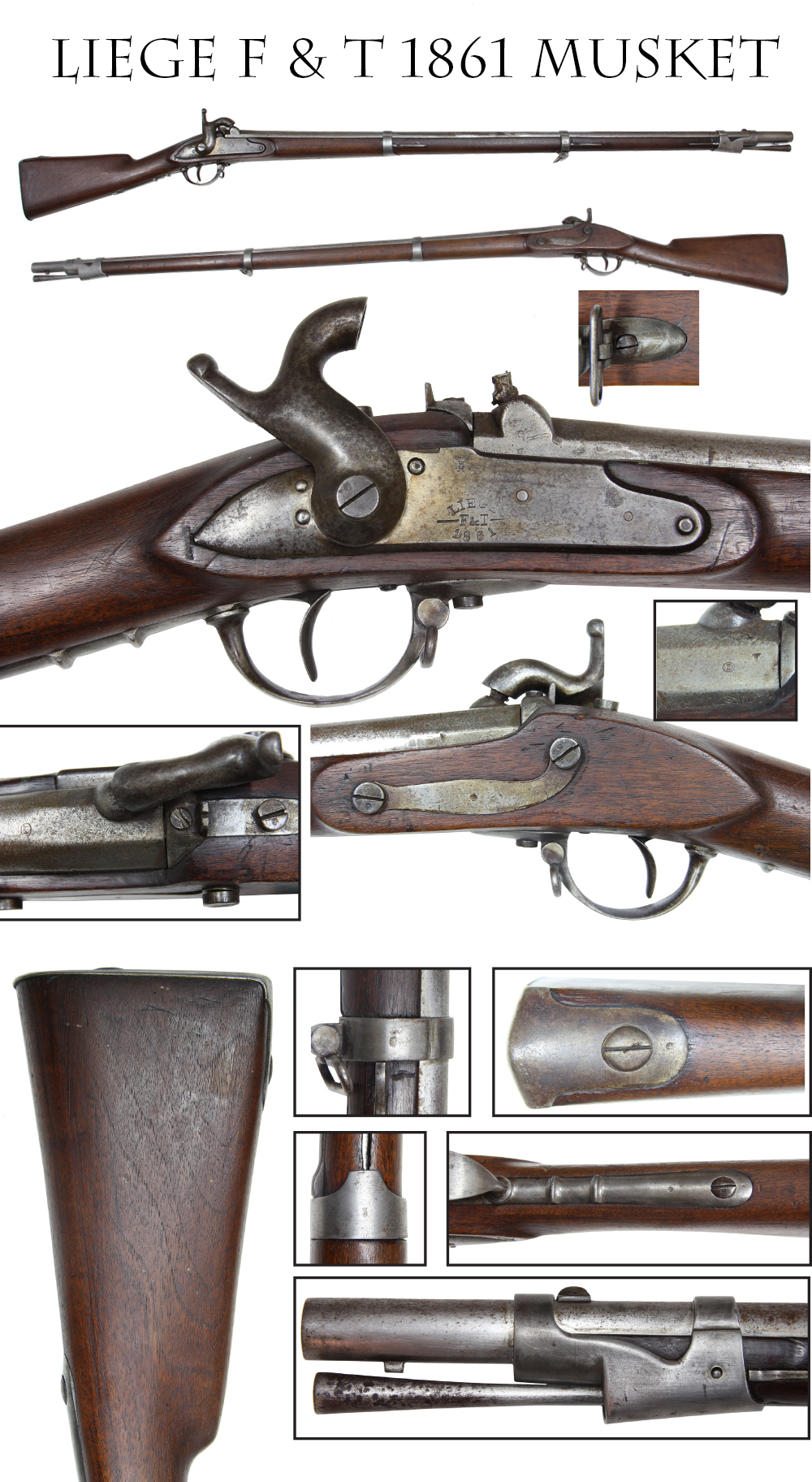
17-03-31…Excellent Condition Liege F & T 1861 Musket -… This imported musket is marked on the lock plate “LIEGE / F & T/ 1861” and also a crown over “H” and is marked on the barrel “ELG”, “S”, and “ET”. This is the firm of Falisse and Trapman in Belgium which produced these 1842 French style muskets which were heavily used by both Union and Confederate troops. The barrel is 40 1/2 inches long, and is a large near 70 caliber with a smooth bore. There is a bayonet lug present on the underside of the barrel. (I can supply a bayonet for $150.) The ramrod is present, and is of a tapered style. The trigger guard plate has two ribs as part of its design. One of the scarcer import muskets to find, and this one is in superior condition. Top shelf condition…. $950.00
sodl
Call us @ 419-842-1863
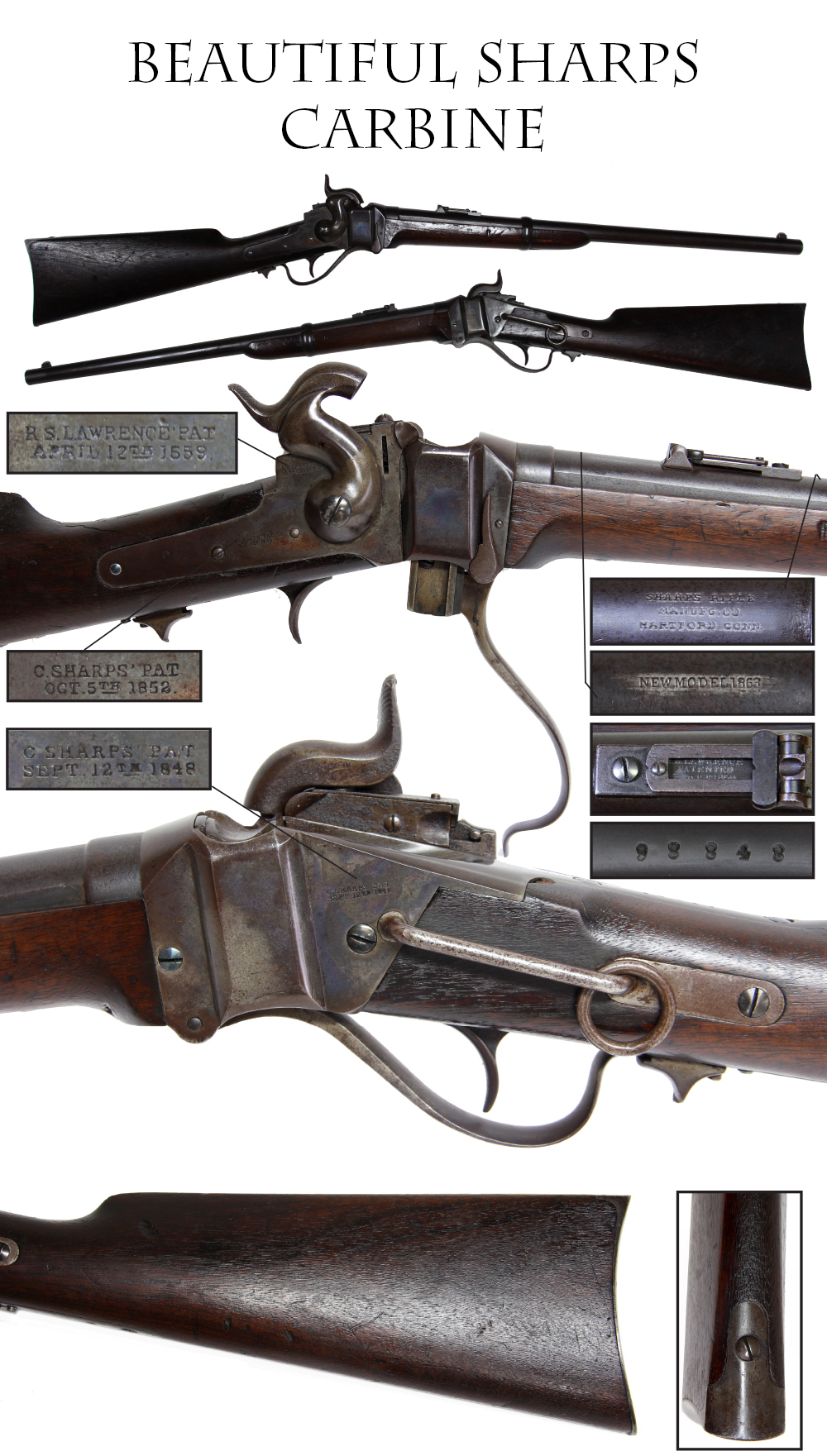
17-03-32…SUPERB 1863 SHARPS CARBINE ….One of the best I’ve found in several years. Extra fine condition with much finish. The most famous, single-shot, percussion firearm used during the Civil War was the Sharps carbine, a .52 caliber, breech loading firearm invented and patented by Hartford, Connecticut native Christian Sharps. Offered here is a very fine specimen of the New Model 1863 Sharps carbine that features serial # 98,848…. late 1864. Carbine has standard 21½ barrel. Barrel address strong with SHARPS RIFLE / MANUFG CO. / HARTFORD, CONN in front of rear sight. NEW MODEL 1863 stamped to rear of sight, lightly cleaned here to highlight the marking. Wood is truly excellent with original finish and deep, rich color. There is a tiny chip just to right of the frame tang All screws are original and in good condition. All gunmetal is in near excellent condition. Barrel blue is 80% or better… turning plum. Case color about 60% or better. Maker markings and patent designations are sharp and distinct. Serial number sharp and strongly stamped unto the upper plate tang. Breech block operating lever mechanics operate smoothly. Hammer / trigger mechanics are crisp. Iron bar tight and retains its iron sling ring. Bore with its six-groove rifling is bright. Not cartouched so this was either a state purchase or commercially purchased carbine. This New Model 1863 Sharps carbine is an extremely fine example of a favorite Civil War cavalry weapon. Hard to improve upon. $2,950.00
sold
Call us @ 419-842-1863

17-03-39…17-03-39 KENTUCKY – PENNSYLVANIA RIFLE SIGNED WM. CRAIG PITTSBURG:… Handsome, long, full stock western Pennsylvania “Kentucky” rifle around 36 caliber. Brass mounted with nice tiger striping to the wood. Side bolster w/ percussion hammer. Clear Pittsburgh stamp on the lock with a less distinct name above it. Very crisp barrel stamp “Wm. Craig / Pittsburg” on the top flat. William Craig was in business with his brother Joseph in Pittsburgh by 1844. By 1849 or 1850 they were operating separately. With the exception of a year or so in California, William worked in the Pittsburg area. I presume he was involved with the Gold Rush. Very elegant drop to the butt. Geometric three-piece patch box tapering to an arched top. Brass hand rail trigger guard. Brass thimbles, nose cap and front sight. Fixed V-notch rear sight. Double set triggers. Barrel a smooth plum brown. Lock and hammer engraved. Hammer engraving is good. Lock engraving is worn at the rear. Some light pitting around the bolster and small chip of burnout wood between hammer and bolster. Nipple shows wear but is not battered down. Action is good. Slight rounding to the wood edges and wear to the color at those points. Simple single tear-drop escutcheon on the offside for the single lock screw. A nice example of a western Pennsylvania rifle that would also fit well in a hunting or early frontier collection. A handsome old Kentucky with much appeal. Even an anti gunner would love this above their fireplace. pdejk…. $895.00
sold
Call us @ 419-842-1863
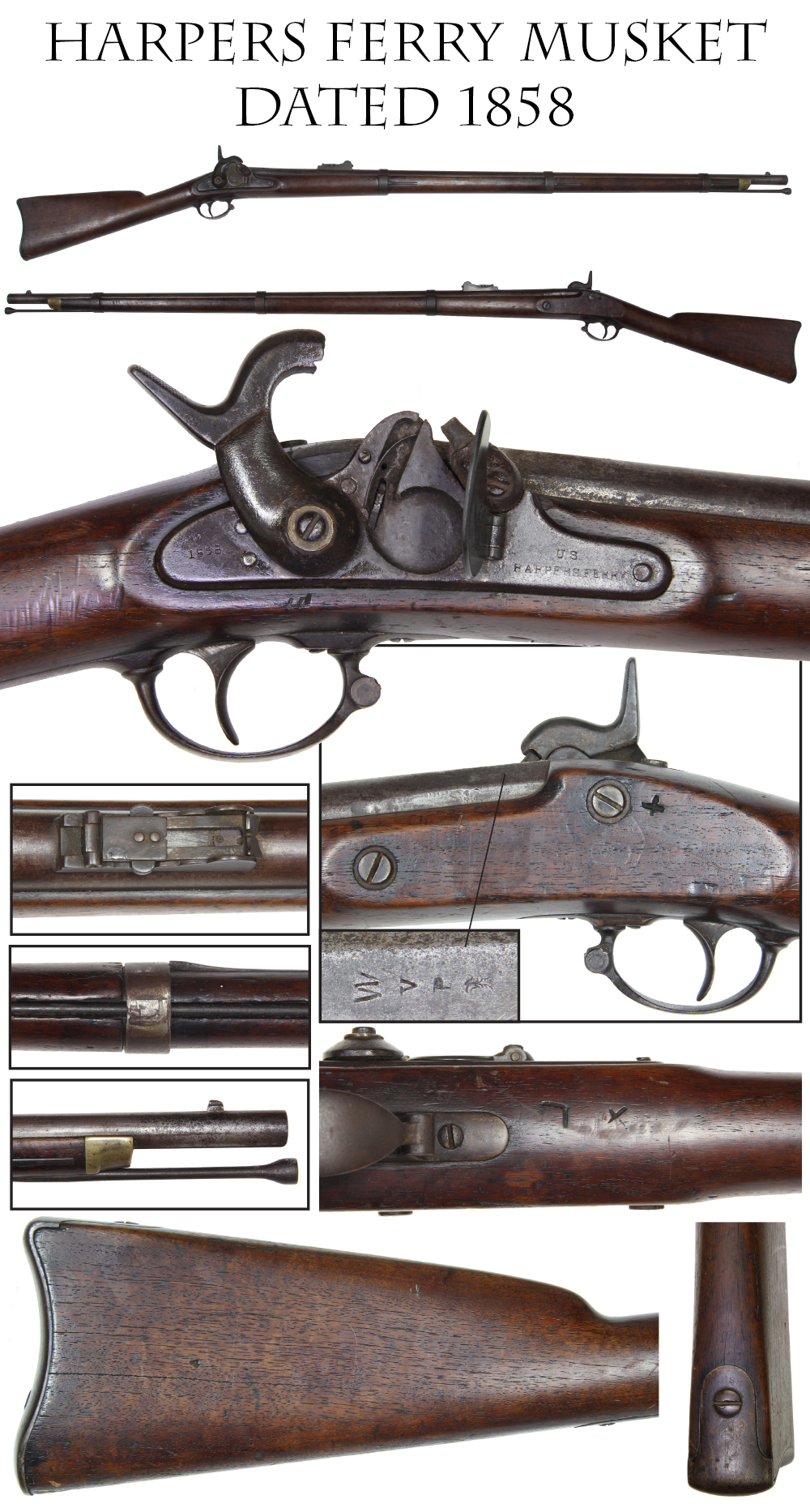
17-03-41….LIKELY CONFEDERATE USED HARPERS FERRY 1855 TYPE – I MUSKET DATED 1858… U.S. 1855 pattern rifle musket produced at the armory of the South at Harpers Ferry, Virginia in 1858. This is a standard first model musket with correct brass nose cap, stock without patchbox, and early style long range rear sight. Both sights, all bands, springs and rod in place. Swivels have been removed from the triggerguard and the upper band. Lock plate markings are clear. Some light corrosion to the plate. Heavier on the bolster from firing. Hammer screw is an old replacement and the primer door is a proper replacement which we restored. Other metal generally smooth and silver gray. Some darker spotting near the muzzle. Clear V/P/eagle head barrel proofs with a W added above them with individual lines. Some spot in my faulty memory associates this crude W with Richmond arms, but I cannot call it to the forefront, and am too lazy to dig through my books. Let me know if you know. A small x is carved next to the upper lock screw and on the underside forward of the triggerguard, along with what looks like the upper portion of a 7. Wood is generally very good, with some slight hairlines in the butt flat and behind the lock plate, but with a tight fit to the lock plate and the visible outlines of a cartouche on the left flat. These rifle muskets were part of the 1855 series of US arms that introduced the .58 caliber Minie ball and other innovations, and this one has a special cachet, coming from the renowned armory at Harpers Ferry, attacked by John Brown before the war and seized by Virginia troops at the beginning of the war. It is hard to stress enough the degree to which Harpers Ferry made examples are rarer than their Springfield made counterparts. The Springfield 1855s are scarce, desirable, and highly sought. In contrast, the Harpers Ferry guns are perhaps 50 times harder to find for sale. Most were used up during the war. Many if not most were used by the South. And most surviving Harpers Ferry examples show hard use and abuse. This one is a VG example, and is absolutely genuine Harpers Ferry from muzzle to butt plate. $3,650.00
sold
Call us @ 419-842-1863
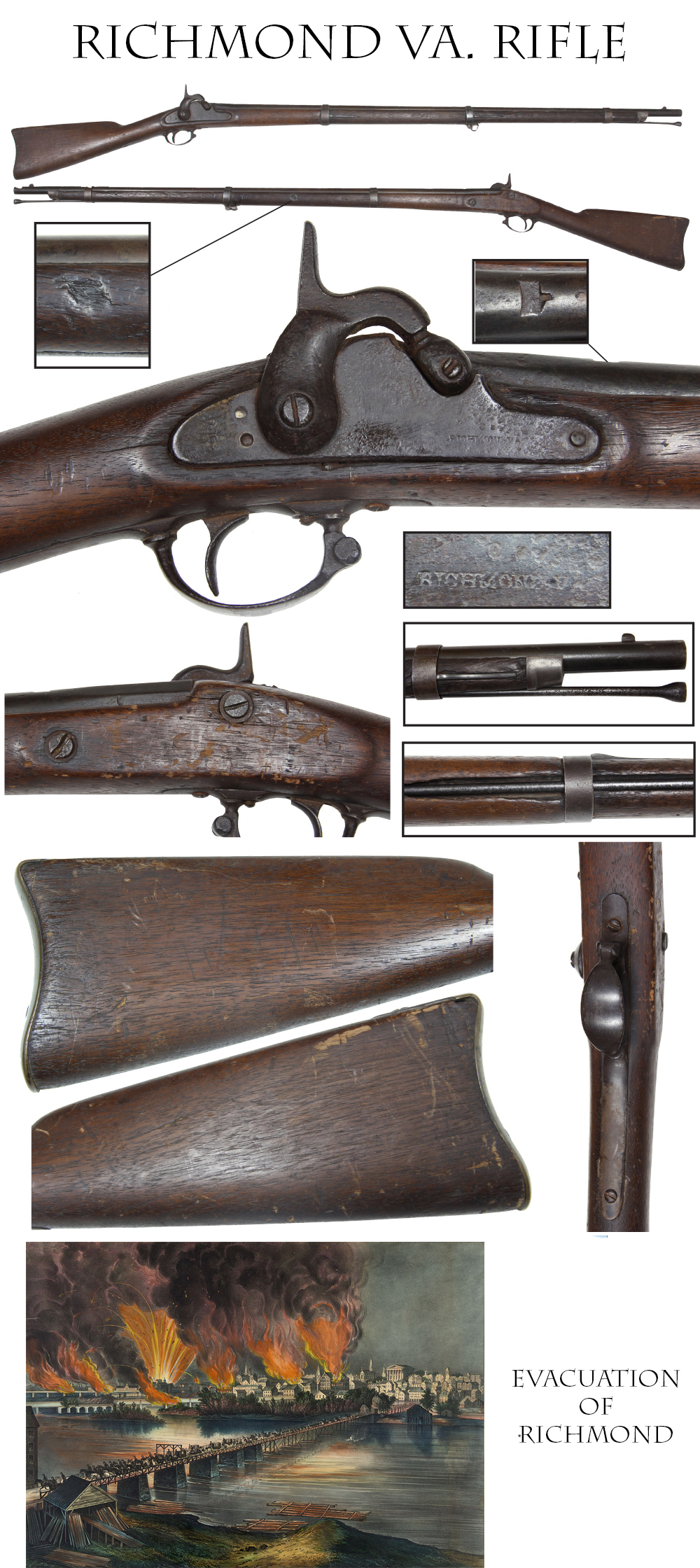
17-03-42… CONFEDERATE RICHMOND RIFLE MUSKET… About as Johnny Reb as you get with a Civil War rifle: a Richmond Rifle-Musket. The most prolific of all the rebel longarms. Made on the US government machinery taken from the Harpers Ferry Armory, these muskets started off using lock forgings and dies intended for the Maynard tape primer system and thus produced this humped lockplate that did away with the priming system but kept the 1855 profile. This one was produced just after the Confederate government took over the production from the state of Virginia. The lock profile is retained, but the lockplate marking now has a C.S. above Richmond, Va. forward of the hammer and an 1862 date vertically behind it. Ours has aged pitting on the plate. The date is light, but legible, and the S is partly gone, but the C of CS is plainly visible above the M of Richmond. Bolster shows some firing corrosion, and there is some corrosion around the nipple. The rear sight is missing, which is something of a plus, since it clearly shows the T-shaped mortise that is characteristic of Richmond barrels. Richmond used the T-mortise for the rear sight (rocker stabilizer) on their sights throughout the war. Springfield quit the practice in 1861 or early 1862. Front sight, bands, ramrod and springs are in place. Front swivel is present, rear swivel is broken off and long gone. The metal shows brown overall with the bands and iron nose cap having some gray. Stock shows good light brown color with light handling marks, one shallow divot between the lower bands, some rounding the edges of the lock platform and some abrasions from use, but nothing unexpected and even anticipated on a Confederate longarm. There is a short crack from the back of the lockplate and on the offside next to the upper lock screw, but the wood is solid and rates good overall. In the right light I see some scratched lines on the right butt flat that might translate into some initials or a name, but I cant guarantee it. When this rebel musket surfaced a few months ago, it had been half stocked for use as a fowler after the war. I am the first dealer/collector to own it since the war. Luckily the barrel was full length with the original front sight. I hated to do it, but I sacrificed an original 1862 Springfield musket in similar condition to obtain the stock forend, ramrod, and the forward two bands. I think my gunsmiths restoration is beyond admirable and it makes this rebel rifle a very affordable REAL Confederate weapon. Aside from this extremely well done restoration using all original parts, the musket is all Richmond. Confederate longarms are notorious for hard use during the war and afterwards. This is a pretty nice example of the most well known Confederate made infantry long arm. I challenge you to find another REAL Richmond musket priced this gently. $3,850.00
sold
Call us @ 419-842-1863

17-03-43…CONFEDERATE TIN CANTEEN… Classic Confederate tin drum canteen with its original leather shoulder sling. Tinned iron body retaining almost all of its tin coating, now a dull gray, with just some scattered brown appearing overall and one small area at left center on one side. All three brackets are firmly in place. Original leather carrying strap with horseshoe buckle and short retaining loop intact, short length as used by cavalry. Strap has a couple of weak spots and one backed repair by a collector. Original solder initials “WI” or “IM” are carved lightly in the strap. Some minor dents and one push on the edge that has caused a short separation from one side, but it is still solid. Displays great with the strap. Very eye catching and getting very hard to find these days. $1,250.00
sold
Call us @ 419-842-1863
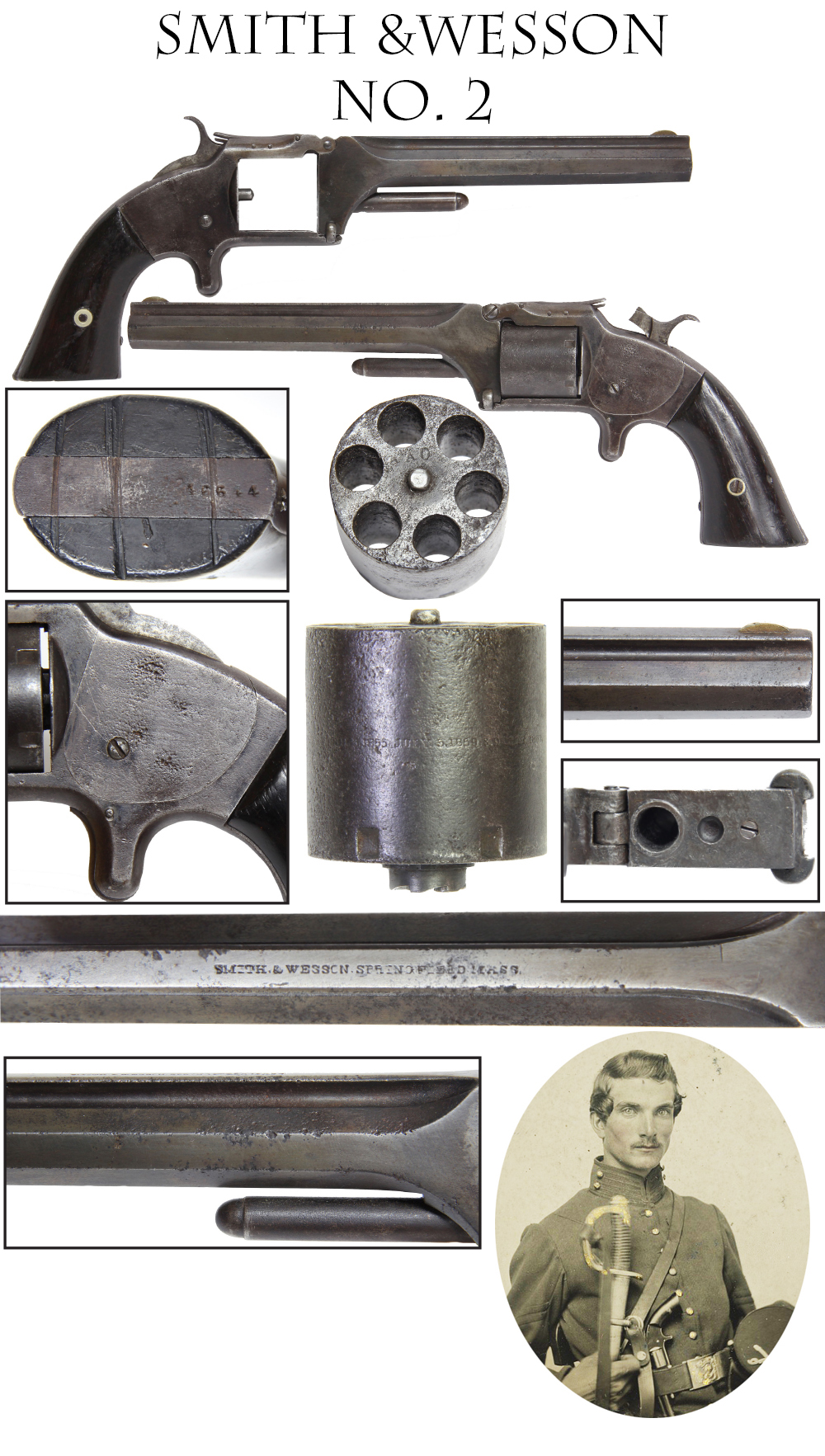
17-03-44…SMITH & WESSON NO. 2… The S&W Model No. 2 “Old Model” revolver was a popular pistol. Some 77,000 were made from 1861 to 1874 and it is a key revolver for Civil War and early western collectors. Custer had a cased pair. Wild Bill Hickok carried one. Many Civil War officers preferred their .32 rimfire cartridges to paper or skin rounds that were subject to damage from rough handling or dampness. This one is overall plum patina. The cylinder shows its patent stamp, but has some light pitting and there are a few patches of it on the left frame below the hammer and some more on the right barrel flat forward of the cylinder. The butt shows three lines scraped across it for some reason. The rosewood grips still have nice rich color. Serial number 46644 on the butt strap, which places it after the war, but in plenty of time for early western use. Priced right at… d … $595.00
sold
Call us @ 419-842-1863

17-03-45..1860 COLT ARMY… The quintessential cavalry trooper’s sidearm, the Colt .44 caliber, six-shot 1860 Army revolver. This one shows wonderful honest use and wear, and is a good solid Civil War veteran, with mismatched serial numbers that were mixed during the war. The age patina on all the parts is absolutely matching and honest. It is deep rust brown mixed with light pitting. Serial numbers are 86,548 on frame, butt strap, and trigger guard, made in 1863… barrel number ends in 5565, cylinder bears 889? I am positive the gun was carried this way during the war. Overall plum brown metal. Barrel address present but light. Some shallow gouges to the top of the barrel near the cylinder and some firing corrosion on the sides. Patent information is visible on the cylinder. The nipples are not battered down and the action is good. Grips show numerous scratches and wear, some rounding to the heel, and have a faint cartouche on left at bottom. A real, field used example of a regulation pistol that was used in all theatres of war by both sides that would be a key part of a cavalry display. You can make a case for Confederate usage based on the heavy patina and mixed number. A good solid Colt. $1,150.00
sold
Call us @ 419-842-1863

17-03-46…INFANTRY OFFICER’S BUGLE, HUNTING HORN, HAT INSIGNIA… Regulation US Civil War hat insignia for an officer of infantry. High quality gilt bullion hand embroidered hunting horn with cords, the branch of service insignia for infantry, on a black velvet oval with jacqueron wire border and sequins around the bell of the horn. Desirable large size. This pattern is made with an interior metal stiffener with two standing loops for attachment to a hat or cap. The border has loosened on the right at some point and was reattached and there is a slight separation along the join of the velvet with the polished cotton reverse, but it is solid and the two small brass wire fastening loops are slightly bent over, but present. The regulation infantry officers insignia. You can attend a hundred antique shows and not find one. These were collected up years ago. $475.00
sold
Call us @ 419-842-1863
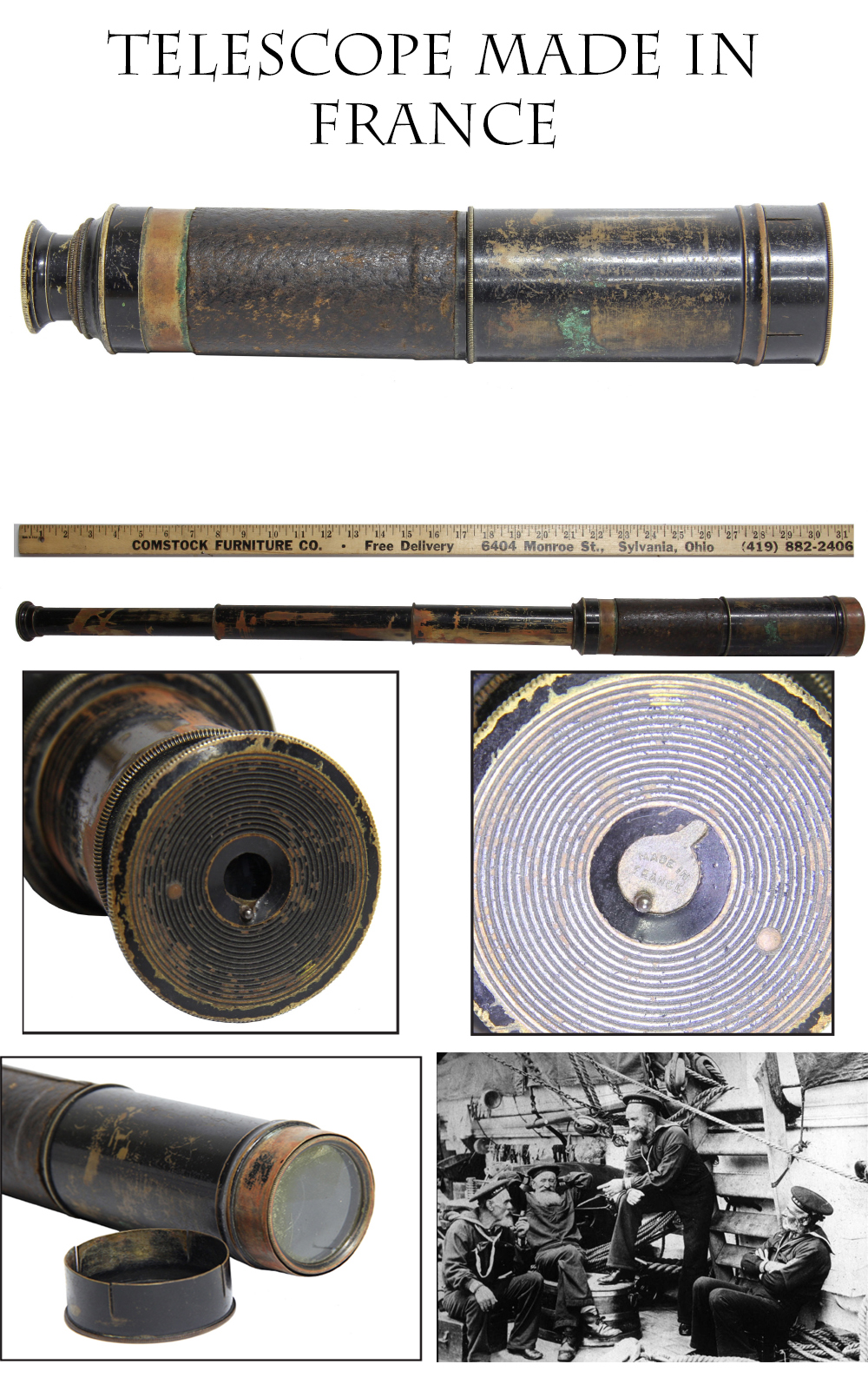
17-03-47…SPANISH WAR TO WW-I PERIOD TELESCOPE MADE IN FRANCE… French optics were well respected in America and around the world. Here is a substantial, three-draw telescope with black japanned and leather covered brass body. The lens cap is present and the pivoting closure on the eyepiece is present and clearly marked Made in France. The japanning on the telescope tubes has worn from use, but the brass has a nice mellow age patina and the colors do not contrast much when opened full length. The leather covered portion of the body is very good, not loose or worn through. An impressive telescope for military or naval use. Very affordable. $150.00
Call us @ 419-842-1863

17-03-48… M1817 COMMON RIFLE DATED 1825 BY JOHNSON… R. & J.D. Johnson had the smallest of the contracts for these rifles, only some 3,000 made from 1824 to 1827. The pattern arms were made at Harpers Ferry, but the production was spread out among several contractors and lasted into the 1840s. This one has a clear U.S./Eagle/ R. & J.D. Johnson stamped lock plate (one of two variants used by this maker) and 1825 over Middn. Conn aft. Matching 1825 barrel date with US/JM inspector marks over a sunken P forward and light Vt. stamp forward of that. This looks like original flint, but isnt. It is an expert reconversion done two generations ago. Front and fixed rear sights in place. All bands, swivels, springs present. Rod is a modern replacement with brass tip. Barrel has a rich plum brown patina, with some silver gray coming through near the breech. Generally smooth metal, but some slanting deep scratches on the barrel just forward of the lock. Tight wood to metal fit around the lock. Slight shrinkage of wood next to barrel tang. Has a visible ink cartouche in the wood on the offside flat. Nice patina to the patch box. Butt plate good, no pitting. Wood stock very good, just minor handling dings and light scratches. A very scarce US military longarm at a fraction the price of original flint $1,650.00
Sold
Call us @ 419-842-1863
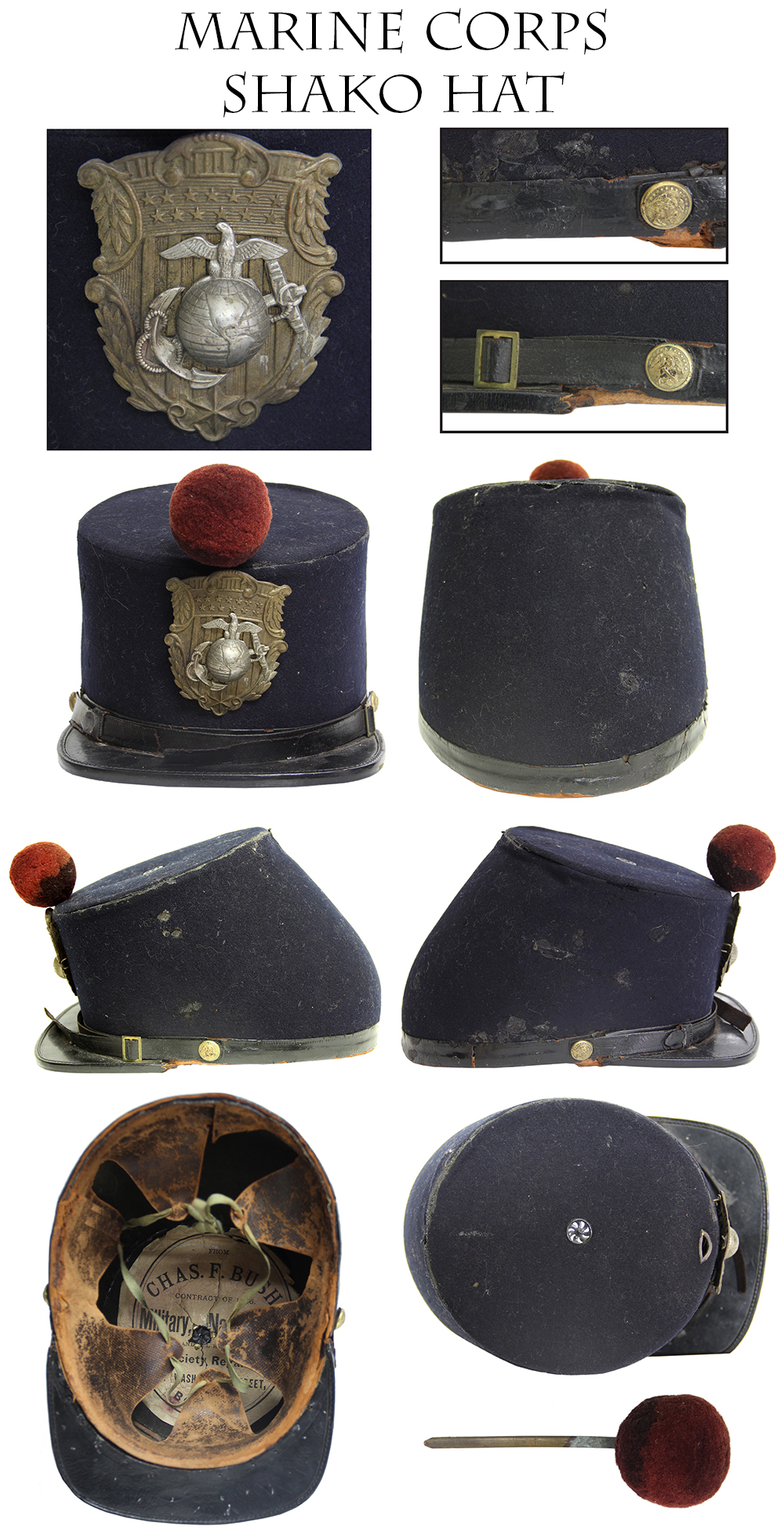
17-03-51 EXCEEDINGLY RARE US MARINE CORPS SHAKO … This is an extremely scarce piece of 19th century American military headgear. It is a contractor marked US Marine Corps 1875 regulation dress cap. The “Real McCoy”. The blue cloth body is in very good condition with just a few stains to the sides that might clean up. The top of the cap is plain blue cloth, as it should be, with a ventilator in the center. The original red wool pompom is present. Interior is very good, with full leather sweatband, triangular tabs and adjusting lace in place. Charles F. Bush, Boston, label on the underside of the crown with a contract date of 1886. He had earlier been part of the firm of Bent & Bush. The label is all there but with some slight tears made when the cap ventilator was installed. USMC side buttons and chinstrap are present. One of the leather chinstrap sections is broken, but no material is missing and it could be mended easily. Original silver EGA insignia on brass shield with nice muted, age patina. An incredibly scarce US regulation marine corps dress cap from the period when US fleets were establishing a world-wide presence. Current prices on common surplus Civil War forage caps is $2500 to $3000. This USMC cap is about 500 times rarer but only costs marginally more.
$3,500.00 Semper-Fi !Sold
Call us @ 419-842-1863
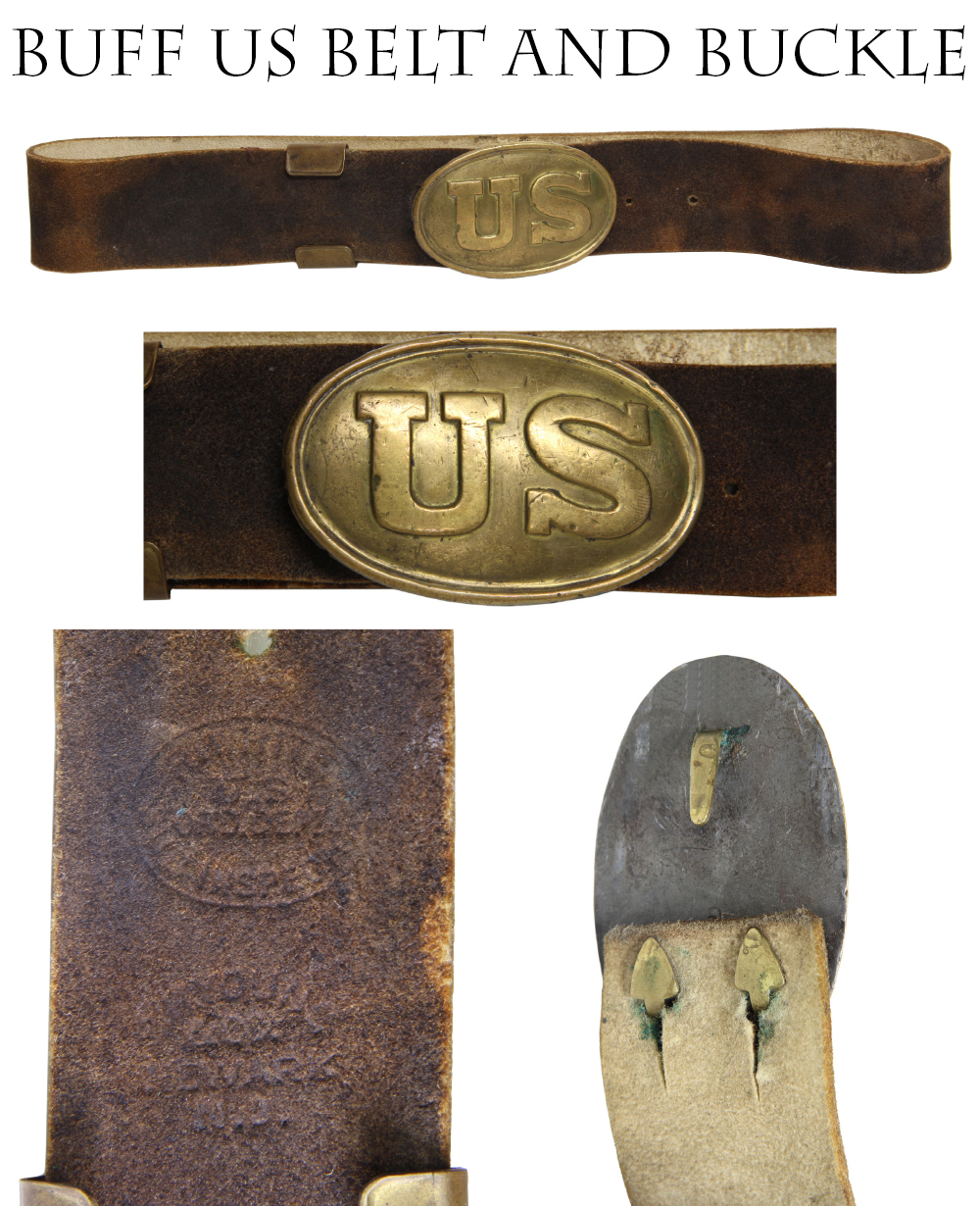
17-03-53… NEAR MINT BUFF US BELT AND BUCKLE … This is the classic Civil War infantry belt with deep clear maker and inspector stamps indicating it was made by Young and inspected by White. In the early days of collecting H.K. White’s, a rival surplus dealer to Bannerman, had a boatload of these, mint and unissued, that were bought by late great dealers such as Bernie Mitchell (the “Bull Run Trader”) and George Gorman Sr., both long dead. These folks then filtered them out to the collecting community for forty to fifty dollars each, which was outrageously expensive in the 1970s. Just a decade earlier during the centennial they had been ten or twenty dollars. This one still has its oval US belt plate with arrow shaped hooks and correct C-clasp retainer. The buff leather is flexible and the color is an even, deep brown, which is actually an oxidized black caused by the iron content of the dye (they probably shifted color within months of issue.) The buckle has an even, muted patina, and no edge dings or battering. A near mint example, just like the old days! $435.00
Call us @ 419-842-1863
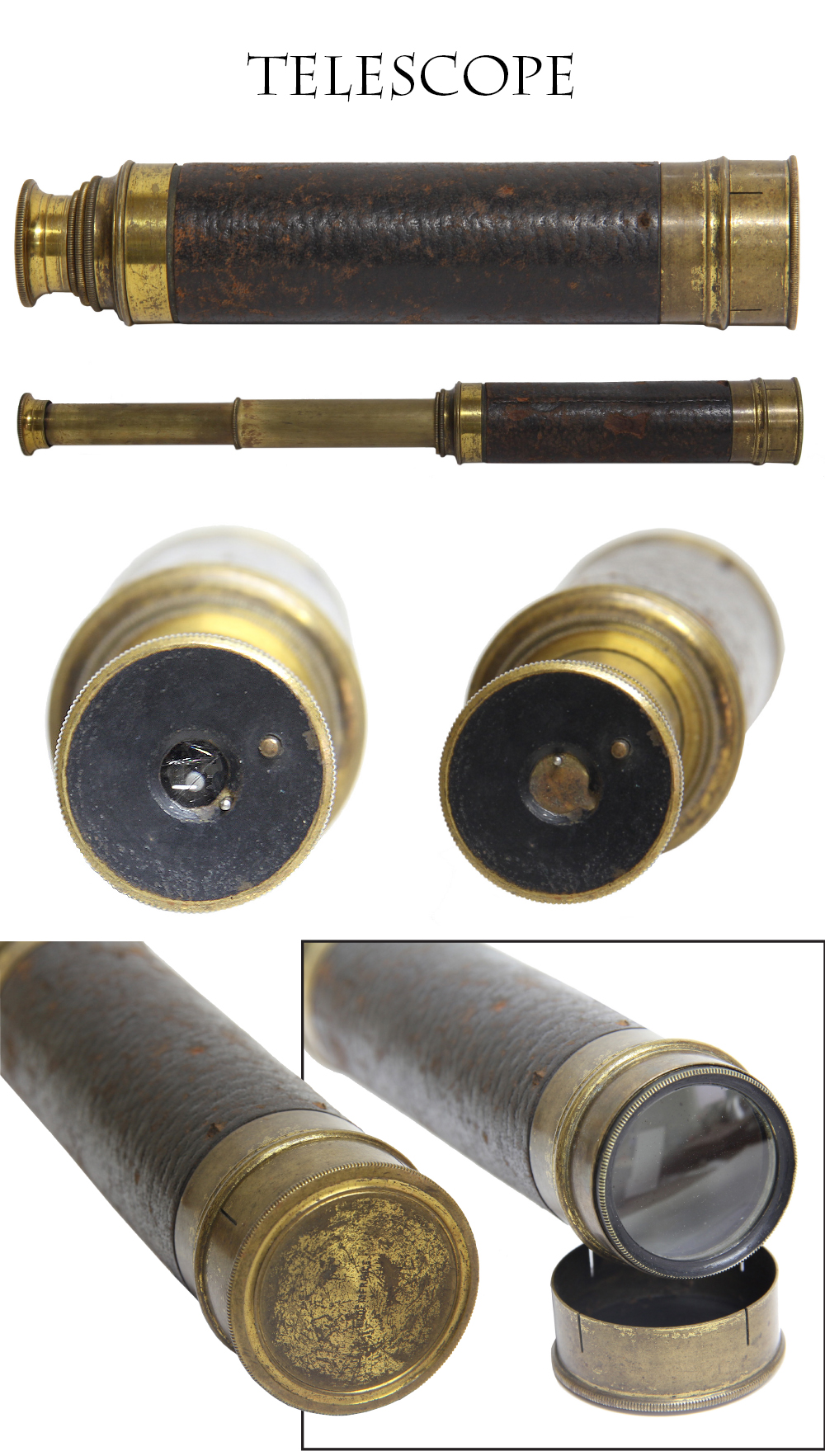
17-03-54… LEATHER BOUND TELESCOPE WW-1 … Classic “two-draw” telescope measuring 7 inches closed and 13.75inches open, with the brass body covered in thin leather, a brass end cap and pivoting shutter for the eye-piece. Classic WW-1 era. The eye-piece lens has cracked, but the telescope displays well and would fit a military or naval display. The lens cap is marked “Made in France,” which comes into being late 19th century to WW-I era for use at sea or in the field. Officer’s purchased their own gear of this sort, so there was a wide variety in actual use. Some gilding is left on concealed spots on the brass, but it has a nice aged patina overall. $135.00
Sold
Call us @ 419-842-1863

17-03-55…US CIVIL WAR OFFICERS SADDLE CLOTH WITH STAFF WREATH INSIGNIA …
. Fresh to the market. Typical early swallowtail form, horizontal strap slits, and a wonderful set of Civil War US staff wreath insignia in the rear corners indicating the rider was a member of a regimental, or more likely, general staff. The heavy blue wool exterior is excellent, with good color, some minor abrasion from use, but no mothing, and is bordered by a one inch wide strip of muted gold bullion lace. Not only is the spine made of leather and the edges reinforced with leather, but the interior is covered with an enameled canvas, showing some wear, but no holes, to prevent horse sweat from soaking through. Superb condition. In the 45 years I have collected and traded in Civil War antiques I have encountered only a handful of these wartime saddle pads. And this is the ONLY one I have ever seen with the US staff wreath insignia embroidered in the corners. I have seen eagles, I have seen stars, … I’ve even seen “Chief of Staff” embroidered on Gen. James Steedman’s example which was later intentionally mis-attributed to Gen. Webb by a long dead shyster who married Steedman’s pad to some genuine Alexander Webb material and then resold the “archive” as being 100% Webb’s. (Sometimes I wish I didn’t know half the stuff I do know.) This is a very showy piece of officer’s horse gear. It displays like gangbusters and is doubly impressive with the officers staff insignia still in place: We had one recent visitor eye the corner insignia with larceny in mind. Each insignia would fetch the better part of a thousand dollars if removed and then attached to a hat! Don’t let THAT happen. $2,950.00 Sold
Call us @ 419-842-1863

17-03-56…PRESENTATION CAVALRY OFFICER’S SABER TO CAPTAIN R.F. DYER 1st MAINE CAVALRY …
A very handsome Horstmann made US cavalry officer’s saber presented to an officer in a hard fighting unit- the First Maine Cavalry! This regiment lost more officers and men killed and mortally wounded than any other cavalry outfit in the war. A shocking 15 officers and 159 enlisted men were killed outright or mortally wounded. It served in the eastern theatre. The regiment recruited in late 1861 and was part of the Departments of the Shenandoah and the Rappahannock, in the Army of Virginia, before joining the Army of the Potomac in September 1862 , where it remained for the rest of the war. Civil War Data lists 136 points at which the regiment saw action and suffered casualties. You can’t get a more fighting cavalry regiment. To top it off, Dyer also had service with the First D.C. Cavalry, famously armed with Henry rifles, before returning to the First Maine in time for the 1864 Virginia Campaign. This saber has a sharkskin wrapped grip with triple wire binding in very good condition. It has a mellow, undisturbed patina to the brass hilt with a simple leaf border on the lower edge of the pommel cap and simple short leaf patterns cast on the exterior of the side branches near the counterguard. The leather bumper pad is still present at the blade shoulder. The etching is very visible, dull silver set off by a light gray, with profuse floral motifs carrying on the guard motifs mixed with some geometric patterns near the guard and a military trophy of flags and spears further up. The blade length is 32 inches, and overall the saber measures 37 inches. The Horstmann business name is etched on one side near the ricasso: “W.H. Horstmann / & Sons / Philadelphia.” The scabbard is a plain, enlisted grade import field scabbard with an S&K mark on the drag. The blade seats well, the contour is perfect, but the scabbard is longer than the blade by several inches. It may have been used this way during the war, or it is possible that an early collector found the saber without a scabbard and married this sheath with it. The previous owner was Ohio collector Tom Jones, and he is no longer with us for me to ask. With the inscription being engraved on the sword guard itself, we know that the weapon is unquestionably Capt. Dyer’s. Nicely engraved on the knuckleguard is a dead-real period inscription, “Presented to Capt. R.F. Dyer, By members of Co. C 1st Maine Cavalry.” Robert F. Dyer was from Augusta, Maine, when he enlisted at age 33 and was commissioned Captain of Co. C of the 1st Maine Cavalry on 10/20/61 and served until 6/1/63 when he resigned and went into the First DC Cavalry, which had eight companies recruited in Maine. He seems to have gone into that regiment first as a lieutenant and then been commissioned again as captain of Company I. This regiment was commanded by Col. Lafayette C. Baker, who was renowned for spying and intelligence activities, and was periodically mired in scandal. The regiment was armed with Henry rifles and intended for “special service” under direct orders from the War Department. In the event, some of the companies ended up on simple field service, some doing dismounted duty, until the Maine men were transferred to the First Maine Cavalry, which brought Dyer back into the regiment on 2/12/64, in time for many actions of the regiment during Grant’s 1864 overland campaign in which the cavalry was very active until his discharge for disability on 11/25/64. Civil War Data records 73 instances of action and casualties for this period of Dyer’s service in the regiment. An exciting presentation cavalry officer’s saber with a lot of history behind it! $3,750.00
Sold
Call us @ 419-842-1863

17-03-57..HARPERS FERRY MODEL 1841 MISSISSIPPI RIFLE… Of all the firms that produced the standard Mississippi rifle, those made and marked by Harpers Ferry Arsenal in Virginia, are perhaps the most sought. This is an outstanding example of a dead-real Harpers Ferry, Va. rifle not a mere contract gun with H.F. lock installed. It is 100% Harpers Ferry from muzzle to butt plate. This has matched dates of 1853 on the lock and barrel. It has the proper JLR inspectors initials on the left side of the stock, opposite the lock, and again inside the patch box. Also, the interior patch box shows the 3 router tip marks peculiar to Harpers Ferry. Oddly the H.F. butt plates were never marked US as is this one. This Mississippi is one of 8,879 such rifles that were rebored to .58 caliber and equipped with an all steel tulip head ramrod at the national armories circa 1855 – 1860. Overall V.G. condition. The only warts are of little consequence. 1) a replaced hammer screw. 2) A brazed repair to a crack in the hammer. Otherwise 100% as it was carried in the Civil War. Has both swivels. Has original V notch rear sight and brass front sight. Decent bore. Mechanically perfect. Steel is overall gun metal gray. All markings are sharp and legible. These are proper to display with US or Confederate infantryman trappings. A good solid Harpers Ferry that you can be proud to display. $2,450.00
Sold
Call us @ 419-842-1863

17-03-58.. Rare Full Flap Military Holster for the Colt Dragoon…Incredibly scarce military holster for the monstrous 44 caliber Colt Dragoon revolver. Very solid, untouched, with great finish and good color. Extra nice condition. End plug in place, stitching firmly intact up and down the edge, belt loop secure with no tears and even the latch tab in place with no damage. Superb in all respects. Only very slight rubbing to the very edges, a little bit of crackling on the latch tab from flexing. Untouched and unmessed with- never even had a whiff of leather dressing. A holster hard to find in any condition. $1,350.00
Sold
Call us @ 419-842-1863
Layaways are Welcome
Need to split your order into multiple payments? No problem! A simple 20% earnest money deposit will hold your item for you.-acf
You can then pay it off in easy installments that fit your budget.
Read Terms Here
Items to Sell? Contact Us
I am always interested in buying ANYTHING from the American Civil War… Guns, Swords, Civil War Muskets, Knives, Uniforms, Flags, Medals, Badges, Diaries, Letters, Autographs, Buttons, photographs, tintypes, daguerreotypes, Insignia, Camp Items, Battlefield Relics, canteens, Drums, Etc… Call 419-842-1863 and ask for Dave Taylor.

